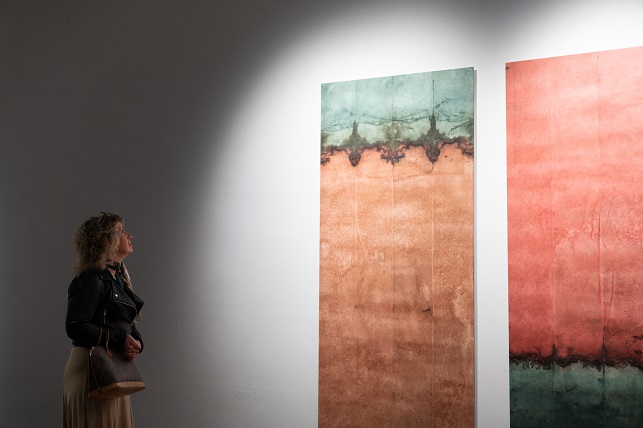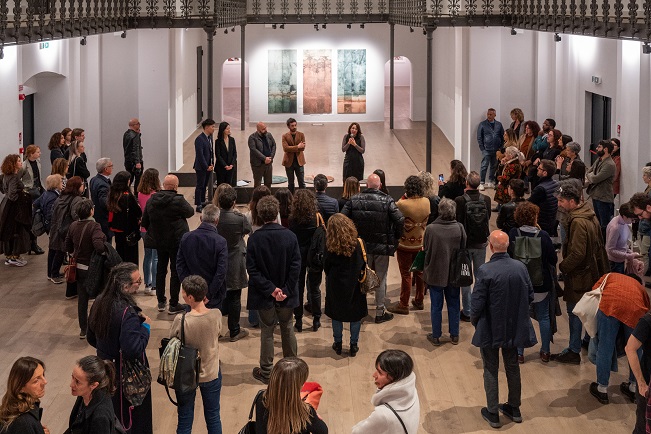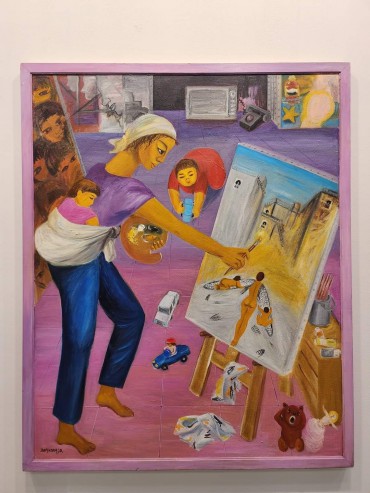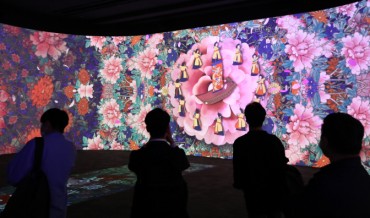
A visitor looks at artworks displayed at the “That’s Korea: Traditional Colors & Practices” exhibition held in the Palazzo Martinengo Colleoni in Brescia. The photo is provide by C.AR.M.E. Multicultural Ethnosocial Arts Center.
SEOUL, April 18 (Korea Bizwire) — The Korean Cultural Center in Italy, in collaboration with the Korea Craft & Design Foundation, recently organized seminars and exhibitions on Korean traditional paper, or “hanji,” in the northern Italian cities of Venice and Brescia from April 13-15.
The events aimed to explore the potential of hanji as a material for cultural heritage restoration and art.
The Marciana National Library (Biblioteca Nazionale Marciana) in Venice, a renowned tourist destination, hosted a seminar on “Excellence and Restoration of Traditional Hanji” last Thursday, showcasing successful cases in which authentic hanji was used to restore cultural properties.
Chiara Fornaciari da Passano, coordinator of the Paper Restoration Laboratory of the “Pope’s Museums,” praised hanji, saying that “it is the first choice when restoring works that are particularly damaged.”
Maria Letizia Sebastiani, former head of the Central Institute for Archives and Book Pathology, also praised hanji for its exceptional quality and revealed that she has used it to restore documents inscribed in the UNESCO Memory of the World Register such as the Rossano Gospels and Leonardo da Vinci’s Codex on the Flight of the Birds.
Jeonju hanji master Choi Sung-il, an Intangible Cultural Property in South Korea, explained the process of making traditional hanji and emphasized that it is made entirely from natural materials, ensuring that it does not deteriorate over time like papers made from chemicals.
Jeonju is renowned for its exceptional hanji and has been producing it since the Goryeo Dynasty (918-1392). Currently, 70 to 80 percent of the country’s total hanji production comes from Jeonju.
In Brescia, an exhibition of naturally dyed hanji works by Riccardo Ayosa, a professor at the National Academy of San Luca, Roma, Italy, opened on April 14.
The opening ceremony was attended by more than 200 people, demonstrating the strong local interest in hanji.

Visitors look at artworks displayed at the “That’s Korea: Traditional Colors & Practices” exhibition held in the Palazzo Martinengo Colleoni in Brescia. The photo is provide by C.AR.M.E. Multicultural Ethnosocial Arts Center.
On Saturday, a seminar on “Modern Applications of Traditional Hanji” was held for 80 local people.
Local Italian restorers who attended the events praised hanji for its strength, thickness, and longevity. “Hanji is a superstar in the restoration world,” said one of the attendees.
Jeon Ye-jin, head of the Korean Cultural Center in Italy, said that the events were a great opportunity to introduce traditional Korean hanji to the restoration and art community in northern Italy.
“As there are many inquiries for purchasing hanji in Italy, we need to come up with a way to make it convenient for people to purchase traditional hanji abroad,” she added.
Jeonju hanji is a symbol of “a thousand years and five hundred,” which represents its power of preservation.
It has been recognized as more valuable than silk in terms of preservation and was even considered a luxury item during the Joseon Dynasty (1392-1910), used as a royal gift and as a tribute to Chinese dynasties of Ming and Qing.
Hanji’s exceptional quality has also been acknowledged compared to Chinese zen paper and Japanese washi paper.
Ashley Song (ashley@koreabizwire.com)






